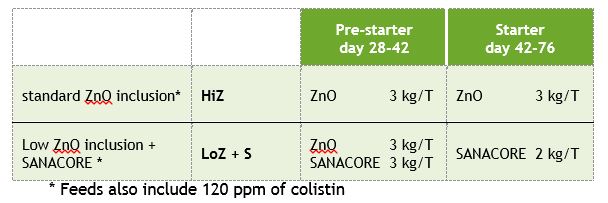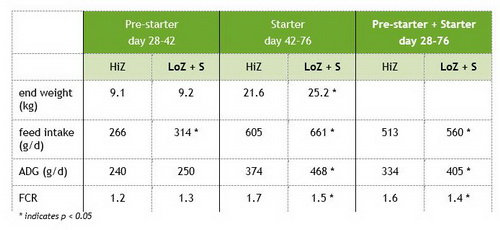



Reducing ZnO by Changing Gut Microbiota
Zinc (Zn) plays an important role in the metabolism of swine and as such is an essential trace element for growing pigs. The element is also known to have negative side effects. Which alternatives exist?Maja Marien and Tim Goossens, business development managers digestive performance, Nutriad International
In piglets higher levels of ZnO in feed are needed to meet their requirements.
In the late 1980’s, it was discovered that pharmacological concentrations (1,500-3,000 ppm) of zinc oxide (ZnO) resulted in reduced diarrhoea and increased growth in weanling pigs. To minimise the risk of environmental pollution, in the EU, the legal norm for Zn is 150 mg/kg (ppm) of Zn in complete animal feed (EU Regulation 1334/2003). Since 2005, ZnO at pharmacological levels has been reallowed in some European countries as a means to reduce the use of antibacterial compounds shortly after weaning.
The mechanisms behind the beneficial effects of ZnO to prevent diarrhoea and promote growth in weaned piglets are not completely understood. Recent advances in research suggest it is achieved through multiple regulatory pathways.
In piglets higher levels of ZnO in feed are needed to meet the requirements due to the fact that Zn absorption after weaning is about 30% reduced and bio-availability may be less than 20%. Moreover, it has been shown that ZnO regulates secretion of brain-gut peptides that stimulate feed intake. This results in the growth promoting effect of ZnO.
ZnO results in an improved intestinal barrier function by increasing the expression of intestinal insulin-like growth factor-1 (IGF 1, regulates cell growth and development) and its receptors and through reducing paracellular permeability by upregulation of tight junction proteins in the intestine.
ZnO reduces the release of pro-inflammatory histamine, by inhibiting proliferation and activation of intestinal mast cells and in this way has an immunomodulating effect.
ZnO also reduces secretion of ions to the intestinal lumen, enhancing water resorption and preventing diarrhoea. Supplementation of weaning diets of piglets with ZnO during a short period of time at relatively high doses (2,500 ppm) enhances stability and diversity of the intestinal microbiota after the change of diet in weaned piglets and it reduces attachment of pathogenic bacteria such as enterotoxigenic E. coli (ETEC) to the intestinal villi.
In addition, it is demonstrated that ZnO prevents the translocation of (pathogenic) bacteria such as E. coli and Enterococcus species in the mesenteric lymph nodes of the small intestine.
Downsides of zinc usage
It is clear that the use of high levels of ZnO (1,500-3,000 ppm) has many positive effects on piglet health and performance. However, such use of pharmacological ZnO dosages has potentially some negative consequences as well.
Zinc toxicity
Pharmacological usage of ZnO for short periods of time (maximum of 14 days) does not cause severe negative consequences for the health of the animal but if used for longer periods, may negatively affect piglet health and performance.
Nutritional interactions
High levels of Zn cause a risk for sub-deficiencies of some minerals such as copper, iron, zinc, and selenium. Also, at pharmacological dosages Zn can form a complex P-phytate and as a consequence the phosphorus cannot be released by the phytase, possibly resulting in a reduced efficacy of phytase and phosphorus deficiency.
Contamination by heavy metals
Impurities such as cadmium in commercial ZnO can be a considerable problem when Zn quality is not strictly controlled.
Zinc and microbial resistance
Although bacterial sensitivity to Zn is not always defined, acquired Zn resistance does seem to occur. Much more alarming, however, is that intensive usage of Zn in animal diets may favour the development of bacterial resistance against other antimicrobials. This can be caused either by an increased production of efflux pumps or by the fact that selection of bacteria resistant to Zn leads to the co-selection of bacteria resistant to some antibiotics, a genetical aspect.
Search for alternatives
Because of these negative aspects of ZnO usage, producers are looking for suitable replacements. When developing an antimicrobial support product, Nutriad has focused on products with a similar mode of action as ZnO. This research has resulted in the development of the product Sanacore EN, a multifunctional product with a broad-spectrum antibacterial approach. The aim of using the product is to reduce the use of ZnO and/or antimicrobials while supporting health and welfare of the animals, as well as to improve production results.
Multifunctional approach
The different components in this strategy cover the same range of positive effects as described above for ZnO. Butyrate, for example, is a strong stimulator of for example glucagon-like peptide-2 (GLP-2). There is a great number of GLP-2-induced effects in the intestine that promote growth and performance: decrease in gastric motility, enhancement of intestinal nutrient transport, stimulation of intestinal blood flow and increase in intestinal cell proliferation. Also it speeds up intestinal mucosa maturation during the development or repair after and up-regulates tight junction proteins in the intestine and in this way decreases intestinal permeability (improved intestinal barrier function). Furthermore, butyrate has been shown to reduce inflammation through its effects on several types of immune cells (immunomodulating effect) and modulates ion absorption and alleviates the severity of the diarrhoea.
The strategy contains several components with a distinct antibacterial spectrum selected ensuring that their combination resulted in a broad antibacterial effect (Gram-negative and Gram-positive). Furthermore, butyrate also stimulates antimicrobial host defense peptides secretion in the GIT. Research done at the University of Bologna in Italy showed that butyrate was able to protect piglets from mortality and from the reduced growth rate due to the E. coli K88 (ETEC) infection.
Field trials
In a first trial, 68 crossbred piglets, weaned at 28 days of age, were allocated to one of two dietary treatments based on live weight (see Tables 1 and 2). The inclusion of the multifunctional product in pre-starter feed (on top of ZnO), resulted in a significant increase in feed intake and ADG (48 g/day and 10 g/day respectively). Inclusion in starter feed (no ZnO) lead to higher performance in comparison with the control group (standard ZnO inclusion): a significant increase in feed intake (56 g/day), in ADG (94 g/day) and a reduced feed conversion rate (FCR), being 0.29 lower.

When looking at the performance results throughout the complete trial period the strategy’s application in pre-starter feed (on top of ZnO) and starter feed (no ZnO), resulted in a significant increase in feed intake (56 g/day), a significant higher ADG (71 g/day), and lower FCR (-0.2) in comparison with a standard ZnO programme (3 kg/tonne throughout pre-starter and starter). At the end of the trial at 76 days of age, piglets receiving the new diet weighed on average 3.6 kg heavier than the piglets from the straight ZnO programme. Faecal consistency was monitored throughout the trial period and no severe diarrhoea was observed in the piglets of both trial groups.

The study demonstrated the potential of a multifunctional strategy to be used in programmes with reduced ZnO levels in weaning piglet diets. Applying that can make a difference for producers aiming to limit the use of ZnO.






